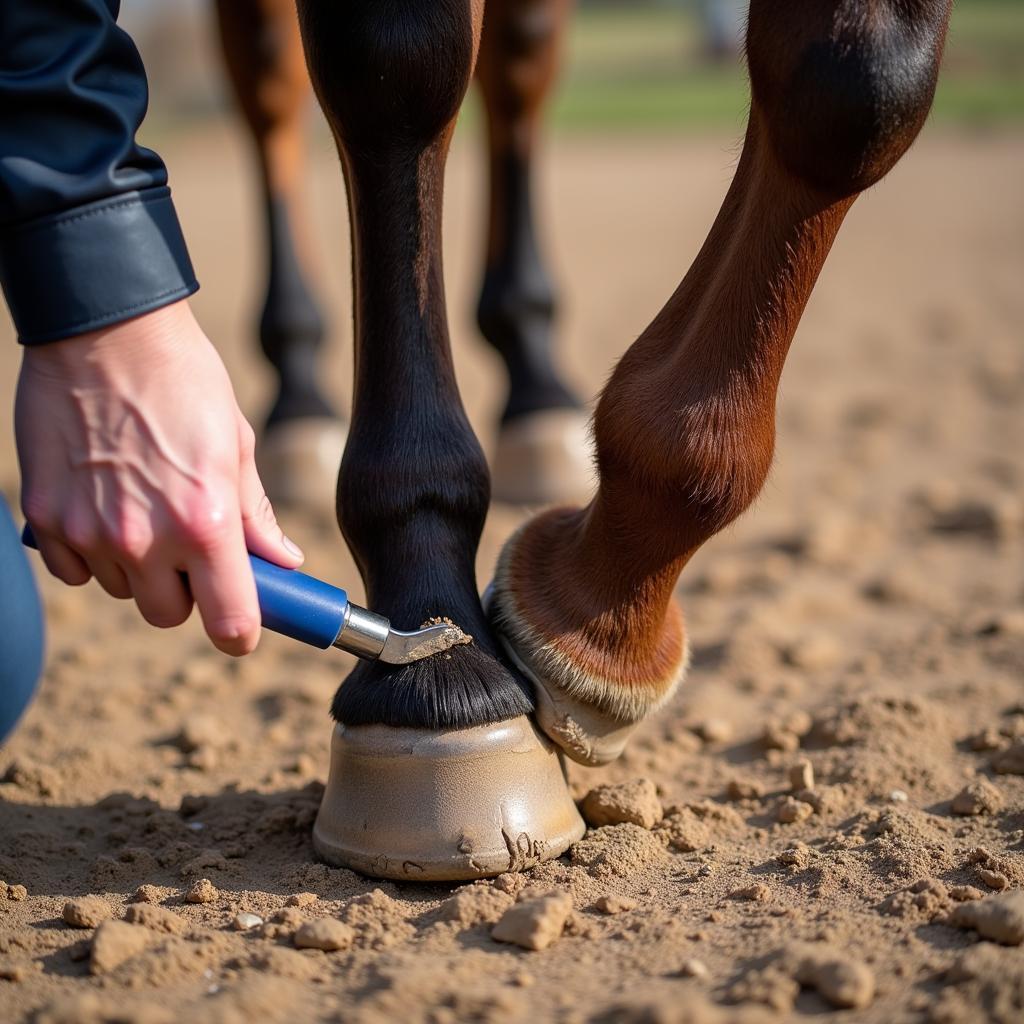Bad Horse Shoeing can have serious consequences for your equine companion’s health and well-being. While it may seem like a straightforward process, there’s more to shoeing a horse than meets the eye. Incorrect shoeing can lead to a range of issues, from discomfort and lameness to long-term hoof damage. Understanding the importance of proper hoof care and recognizing the signs of bad horse shoeing is crucial for any horse owner.
Why Proper Horse Shoeing Matters
A horse’s hooves are more than just hard coverings; they are complex structures that bear the animal’s entire weight and absorb shock with every step. Just like our feet, hooves need to be properly balanced and maintained to ensure comfort and mobility.
Here’s why proper horse shoeing is so vital:
- Weight distribution: Correct shoeing ensures even weight distribution across the entire hoof, preventing strain on tendons, ligaments, and joints.
- Hoof health: Well-fitted shoes protect the hoof from excessive wear and tear, while also allowing for natural expansion and contraction.
- Performance: Proper shoeing can enhance a horse’s gait, balance, and overall performance, whether for riding, racing, or working.
Telltale Signs of Bad Horse Shoeing
Identifying bad horse shoeing early is essential to prevent further complications. Here are some red flags to watch out for:
- Lameness or reluctance to move: This is often the most obvious sign that something is wrong.
- Stumbling or tripping: Uneven hooves or improperly placed shoes can disrupt a horse’s natural gait.
- Unusual hoof growth: Overgrown hooves, cracks, or rings can indicate chronic shoeing issues.
- Heat in the hoof: An unusually hot hoof can signal inflammation or infection, potentially caused by pressure from a poorly fitted shoe.
- Nails too close to the sensitive areas: If a farrier drives nails too close to the sensitive laminae of the hoof, it can cause significant pain and lameness.
The Farrier Factor: Finding a Skilled Professional
The expertise of the farrier plays a critical role in ensuring proper horse shoeing. Choosing a qualified and experienced farrier is crucial for your horse’s well-being. Here’s what to consider:
Experience and Qualifications:
- Certifications: Look for farriers certified by reputable organizations, such as the American Farrier’s Association.
- Experience: An experienced farrier will have encountered and addressed a wider range of hoof issues.
- Continuing Education: Farriers who pursue continuing education stay updated on the latest techniques and technologies.
Communication and Approach:
- Observational Skills: A good farrier takes the time to observe your horse’s conformation, movement, and hoof condition.
- Communication: They should be able to clearly explain their assessment and shoeing plan.
- Willingness to collaborate: A skilled farrier is open to working with you and your veterinarian to address your horse’s specific needs.
Long-Term Consequences of Neglecting Hoof Care
Ignoring bad horse shoeing can have lasting repercussions on your horse’s health:
- Chronic Pain and Lameness: Persistent discomfort can severely impact a horse’s quality of life.
- Joint Problems: Uneven weight distribution due to improper shoeing can strain joints, leading to arthritis and other degenerative conditions.
- Hoof Deformities: Chronic shoeing issues can cause permanent changes in hoof shape and structure.
Proactive Hoof Care: Tips for Horse Owners
 Horse owner diligently cleaning a horse's hoof
Horse owner diligently cleaning a horse's hoof
Maintaining healthy hooves is an ongoing commitment. Here are some proactive measures you can take:
- Regular Hoof Care Routine: Clean your horse’s hooves daily, removing dirt, debris, and packed snow.
- Schedule Farrier Appointments: Aim for shoeing or trimming every 6-8 weeks, or as recommended by your farrier.
- Provide a Balanced Diet: Ensure your horse receives adequate nutrition, including biotin and other nutrients crucial for hoof health.
- Monitor for Changes: Be attentive to any changes in your horse’s gait, hoof condition, or behavior.
Conclusion
Bad horse shoeing can have detrimental effects on your horse’s well-being. Understanding the signs of improper shoeing, choosing a skilled farrier, and prioritizing proactive hoof care are crucial steps in ensuring your equine partner enjoys a long, healthy, and active life. By working closely with your farrier and veterinarian, you can keep your horse’s hooves in top condition, promoting their comfort and performance.
FAQs
Q: How often should my horse see a farrier?
A: Generally, horses should have their hooves trimmed or shod every 6-8 weeks. However, factors such as hoof growth rate, discipline, and individual needs can influence this frequency.
Q: What should I look for in a qualified farrier?
A: Look for certifications, experience, a commitment to continuing education, excellent communication skills, and a willingness to collaborate with you and your veterinarian.
Q: Can bad horse shoeing cause lameness?
A: Yes, improper shoeing can lead to discomfort, pain, and lameness in horses. Uneven weight distribution, pressure points, and nail placements can all contribute to lameness.
Q: How can I help my horse maintain healthy hooves?
A: Establish a regular hoof care routine, schedule consistent farrier appointments, provide a balanced diet that supports hoof health, and monitor your horse for any changes in gait or hoof condition.
Q: What are some common hoof problems associated with bad horse shoeing?
A: Common issues include abscesses, cracks, thrush, contracted heels, and navicular disease.
Need assistance with your horse’s hoof care? Contact us at Phone Number: 0772127271, Email: [email protected]. Or visit us at: QGM2+WX2, Vị Trung, Vị Thuỷ, Hậu Giang, Việt Nam. Our dedicated team is available 24/7 to address your concerns.